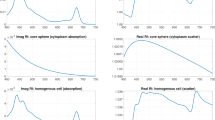Abstract
We investigate the accuracy with which relevant atmospheric parameters must be estimated to derive phytoplankton pigment concentrations (chlorophyll a plus phaeophytin a ) of a given accuracy from measurements of the ocean's apparent spectral radiance at satellite altitudes. The analysis is limited to an instrument having the characteristics of the Coastal Zone Color Scanner scheduled to orbit the Earth on NIMBUS-G. A phytoplankton pigment algorithm is developed which relates the pigment concentration (C) to the three ratios of upwelling radiance just beneath the sea surface which can be formed from the wavelengths (λ) 440, 520 and 550 nm. The pigment algorithm explains from 94 to 98% of the variance in log10 C over three orders of magnitude in pigment concentration. This is combined with solutions to the radiative transfer equation to simulate the ocean's apparent spectral radiance at satellite altitudes as a function of C and the optical properties of the aerosol, the optical depth of which is assumed to be proportioned to λ-n. A specific atmospheric correction algorithm, based on the assumption that the ocean is totally absorbing at 670 nm, is then applied to the simulated spectral radiance, from which the pigment concentration is derived. Comparison between the true and derived values of C show that: (1) n is considerably more important than the actual aerosol optical thickness; (2) for C 0299-1 0.2 Μg l-1 acceptable concentrations can be determined as long as n is not overestimated; (3) as C increases, the accuracy with which n must be estimated, for a given relative accuracy in C, also increases; and (4) for C greater than about 0.5 Μg 1-1, the radiance at 440 nm becomes essentially useless in determining C. The computations also suggest that if separate pigment algorithms are used for C ≲ 1Μgl-1 and C ≳ 1 Μgl-1, accuracies considerably better than ±± in log C can be obtained for C ≲ 1 Μg l-1 with only a coarse estimate of n, while for C ≳ 10 Μgl-1, this accuracy can be achieved only with very good estimates of n.
Similar content being viewed by others
References
Arvesen, J. C., Millard, J. P., and Weaver, E. C.: 1973, ‘Remote Sensing of Chlorophyll and Temperature in Marine and Fresh Waters’, Astronaut. Acta. 18, 229–239.
Clarke, G. K. and Ewing, G. C.: 1974, ‘Remote Spectroscopy of the Sea for Biological Production Studies’, in N. G. Jerlov and E. Steeman Nielsen (eds.), Optical Aspects of Oceanography, Academic Press, pp. 389–414.
Clarke, G. K., Ewing, G. C., and Lorenzen, C. J.: 1970, ‘Spectra of Back-scattered Light from the Sea Obtained from Aircraft as a Measure of Chlorophyll Concentration’, Science 167, 1119–1121.
Curran, R. J.: 1972, ‘Ocean Color Determination Through a Scattering Atmosphere’, Appl. Optics 8, 1857–1866.
Duntley, S. Q., Austin, R. W., Wilson, W. H., Edgerton, C. F., and Moran, S. E.: 1974, ‘Ocean Color Analysis’, Final Report, Naval Res. Lab. Contract: N00014-69-A-0200-6033 and Nat'l. Ocean. and Atm. Admin. Grant No. 04-3-158-64. Scripps Inst. of Ocean., Ref. 74-10.
El-Sayed, S. Z., Taguchi, S., Franceschini, G. A., Fryxell, G. S., and Gates, C. E.: 1977, ‘Phytoplankton and Primary Productivity Studies’, Final Report to Deep Ocean Mining Environmental Study, 197 pp.
Gordon, H. R. and McCluney, W. R.: 1975, ‘Estimation of the Depth of Sunlight Penetration in the Sea for Remote Sensing’, Appl. Optics 14, 413–416.
Gordon, H. R.: 1978, ‘Removal of Atmospheric Effects from Satellite Imagery of the Oceans’, Appl. Optics 17, 1631–1636.
Holm-Hansen, O. G., Lorenzen, G. J., Holmes, R. W., and Strickland, J. D. H.: 1965, ‘Fluorometric Determination of Chlorophyll’, J. Cons. Perm. Int. Explor. Mer. 30, 3–15.
Hovis, W. A. and Leung, K. C.: 1977, ‘Remote Sensing of Ocean Color’, Opt. Eng. 16, 153–166.
Keifer, D. A.: 1975, personal communication.
Larrance, J.: 1976, ‘Phytoplankton and Primary Productivity in the Northeastern Gulf of Alaska’, Environmental Assessment of the Alaskan Continental Shelf 7, 57–93.
Larrance, J.: 1977, personal communication.
Larrance, J., Tennant, D. A., Chester, A. J., and Ruffio, P. A.: 1977, ‘Phytoplankton and Primary Productivity in the Northeastern Gulf of Alaska and Lower Cook Inlet’, Environmental Assessment of the Alaskan Continental Shelf 10, 1–137.
Morel, A. and Prieur, L.: 1977, ‘Analysis of Variations in Ocean Color’, Limnology and Oceanog. 22, 709–722.
Nelsen, T. A.: 1975, personal communication.
Prospero, J. M., Carlson, T. N., Savoie, D., and Nees, R. T.: 1976, ‘Atmospheric Turbidity Measurements During GATE’, Technical Report TR76–6, University of Miami, Rosenstiel School of Marine and Atmospheric Science, Miami, Fl.
Ramsey, R. C. and White, P. G.: 1973, ‘Ocean Color Data Analysis Applied to MOCS and SIS Data’, Final Report. NOAA Contract No. N62306-72-C-0037, 75 pp.
Smith, R. C. and Baker, K. S.: 1978, ‘The Bio-optical State of Ocean Waters and Remote Sensing’, Limnol. Oceanogr. 23, 260–267.
Vernon, L. P.: 1960, ‘Spectrophotometric Determination of Chlorophylls and Phaeophytins in Plant Extracts’, Anal. Chem. 32, 1144–1150.
Yentsch, C. S.: 1965, ‘Distribution of Chlorophyll and Phaeophytin in the Open Ocean’, Deep-Sea Res. 12, 653–666.
Yentsch, C. S. and Menzel, D. W.: 1963, ‘A Method for the Determination of Phytoplankton Chlorophyll and Phaeophytin by Fluorescence’, Deep-Sea Res. 10, 221–231.
Author information
Authors and Affiliations
Additional information
Contribution No. 387 from the NOAA/ERL Pacific Environmental Laboratory.
On leave from Department of Physics, University of Miami, Coral Gables, Florida.
Rights and permissions
About this article
Cite this article
Gordon, H.R., Clark, D.K. Atmospheric effects in the remote sensing of phytoplankton pigments. Boundary-Layer Meteorol 18, 299–313 (1980). https://doi.org/10.1007/BF00122026
Received:
Issue Date:
DOI: https://doi.org/10.1007/BF00122026




